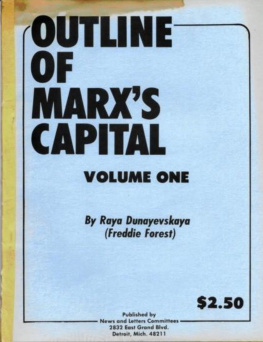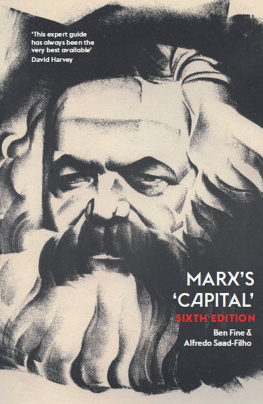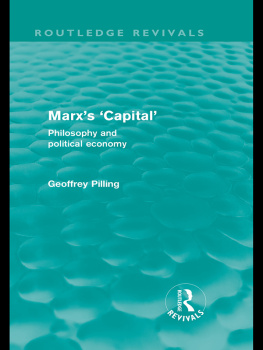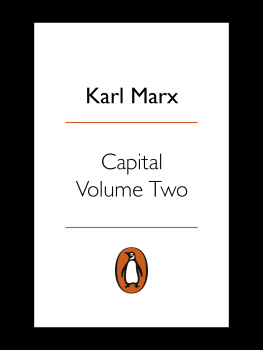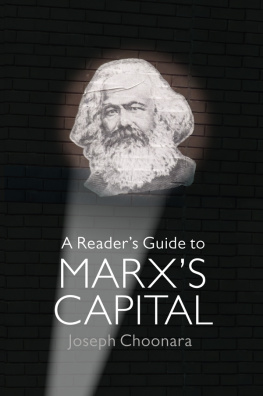Raya Dunayevskaya - Outline of Marxs Capital Volume 1
Here you can read online Raya Dunayevskaya - Outline of Marxs Capital Volume 1 full text of the book (entire story) in english for free. Download pdf and epub, get meaning, cover and reviews about this ebook. year: 1979, publisher: Marxist Internet Archive, genre: Romance novel. Description of the work, (preface) as well as reviews are available. Best literature library LitArk.com created for fans of good reading and offers a wide selection of genres:
Romance novel
Science fiction
Adventure
Detective
Science
History
Home and family
Prose
Art
Politics
Computer
Non-fiction
Religion
Business
Children
Humor
Choose a favorite category and find really read worthwhile books. Enjoy immersion in the world of imagination, feel the emotions of the characters or learn something new for yourself, make an fascinating discovery.
- Book:Outline of Marxs Capital Volume 1
- Author:
- Publisher:Marxist Internet Archive
- Genre:
- Year:1979
- Rating:5 / 5
- Favourites:Add to favourites
- Your mark:
- 100
- 1
- 2
- 3
- 4
- 5
Outline of Marxs Capital Volume 1: summary, description and annotation
We offer to read an annotation, description, summary or preface (depends on what the author of the book "Outline of Marxs Capital Volume 1" wrote himself). If you haven't found the necessary information about the book — write in the comments, we will try to find it.
Outline of Marxs Capital Volume 1 — read online for free the complete book (whole text) full work
Below is the text of the book, divided by pages. System saving the place of the last page read, allows you to conveniently read the book "Outline of Marxs Capital Volume 1" online for free, without having to search again every time where you left off. Put a bookmark, and you can go to the page where you finished reading at any time.
Font size:
Interval:
Bookmark:
The Outline was published as a pamphlet by News & Letters Committees in 1979, but was written by Raya Dunayevskaya decades earlier (c1946). The Outline was originally produced as an educational tool for use within the Workers Party (USA).
This ebook version was created by Chris Gilligan from the web version available on the Marxist Internet Archive (available at: https://www.marxists.org/archive/dunayevskaya/works/1979/outline-capital/index.htm ). The web version was transcribed from the 1979 edition, for Marxist Internet Archive, by Damon Maxwell.
This ebook version was converted from the web version to ebook formats (epub, mobi and pdf) by Chris Gilligan. The text was then checked against the digital copy of the 1940s original mimeographed copy available at the Marxist-Humanist Initiative website: (available at: https://www.marxisthumanistinitiative.org/archives-of-marxist-humanism ), and some minor corrections were made.
Dunayevskaya (Freddie Forest) formed the Johnson-Forest Tendency (or State-Capitalism Tendency) with CLR James (JR Johnson) while they were both members of the Workers Party (USA). The Workers Party was formed by a group who split from the Socialist Workers Party (USA) in 1940, in opposition to the Soviet invasion of Finland, and to Trotsky's characterisation of Stalinist Russia as a 'degenerated workers' state'. This breakaway group included, (in addition to CLR James and Raya Dunayevskaya), Max Shachtman (who became the leader of the SWP), Hal Draper, Martin Abern, Joseph Carter, Julius Jacobson, Phyllis Jacobson, Albert Glotzer, Stan Weir, B. J. Widick, and Irving Howe.
It is possible to teach CAPITAL in fourteen lectures. A few elementary suggestions will facilitate the orientation of both teacher and pupil. For example, chalk and a blackboard do a lot to make visual complex formulae. It is easier to remember any formula when it is written white on black than when it is spoken. It also becomes a matter of course under these circumstances to initial oft-repeated Marxian categories. This is true not only of such expressions as constant capital (c.c.), variable capital (v.c.) and surplus value (s.v.) but even the lengthier and never-abbreviated one, socially-necessary labor time (s.n.l.t.).
With the exception of the introductory and concluding lectures, questions are appended at the end of each lecture. However, a word of caution is necessary. The question and answer method does not lend itself too well to the study of Part I. The questions, however, can be of help here too, provided the teacher is well aware that it is as essential to grasp Marxs dialectic method as it is to comprehend the economic analysis. In fact, unless we get hold of this method of analysis, the analysis itself cannot be fully understood. It is necessary, therefore, to emphasize that if we were to answer use-value and value to the question: What are the characteristics of a commodity? we simply would not begin to cover the importance of the two-fold nature of commodities. This is so because the and in this case is not so much a conjunction as a counter-position, that is, it is a use-value on the one hand and a value on the other hand.
In the use-value and value of a commodity is contained, in germ the whole contradiction of the capitalist system; it is the reflection of the class struggle itself. It is important, therefore, that along with the questions, the teacher devise key sentences to this section to help the student comprehend not merely the answer to the question, but the method of answering. Here is an example: The teacher explains that the key sentence for section 1 of Chapter I is the two factors of a commodity, use-value and value, are of polar contrast and yet are interdependent. Here, too, the blackboard does much to make the meaning stick. Written out on the blackboard, this key sentence, extended also to include exchange value, would look like this:
 figure 1
figure 1
Chapter I is the most difficult section of all of CAPITAL. Hence, a lot of work should be put into it. In addition to the outline of the lecture, the questions, the key sentences, attention should be drawn to the examples of historical materialism contained in it. I have appended a partial listing of them at the end of the questions.
Cross references are important both because they include various aspects of the same question, and because they help keep the student interested since they give him a birds eye view of the sections of the book far ahead of the particular one being studied. Cross references are included both within the text of the outline and in some questions.
Three methods of teaching may be applied throughout the course:
I. A student is asked to be teacher for one session, or
II. The class is divided into four sections and each section is asked to read a particular chapter and submit, in written form, two types of questions; 1) the kind the pupil would like to have explained to him, or (2) the kind the pupil would ask if he were teacher, this method should be used toward the end of each part of the work covered. The questions should be read out to the class and analyzed from two points of view: (l) whether the teacher had made himself understood by dealing with the questions the pupils had in mind, and (2) to compare the different reactions to the same material by the different students, which generally depend on that previous acquaintance with the subject each had.
III. The material that is to be dealt with in the given lecture is divided up and assigned to various students who are not asked to make a report. However, while the teacher is delivering the lecture, he stops and directs questions to the students regarding the special assignments each was to cover.
The first lecture is of primary importance because it does much to decide whether the students will remain through-out the course or whether they will drift away. This introductory lecture, entitled The Aim, structure and Scope of CAPITAL comprises the prefaces to CAPITAL, the Marx-Engels correspondence regarding the work and an explanation of the structure of the eight parts of CAPITAL.
The teacher should note the contents page where the fourteen lectures are listed under five divisions: (I) Introduction; (II) The Phenomena of Capitalism; the Buying and Selling of Commodities; (III) the Essence of Capitalism which is subdivided into (l) The Capitalist Labor Process or the Production of Surplus Value and (2) The Results of the Capitalist Labor Process or the Transformation of the Value of Labor Power into Wages; (IV) The Law of Motion of Capitalist Society; and (V) Conclusion. These divisions will help in giving the lectures a certain cohesiveness and direction, instead of letting each individual lecture hang by itself.
By the time the members of the class have reached the end of this course, they should be well aware of the fact that CAPITAL has not been studied as theory for theorys sake, but as a guide to action. In the ensuing discussion the class should be encouraged to try to apply the main postulates of CAPITAL to the American economy. Stress should therefore be laid on Trotskys Living Thoughts of Karl Marx, where he does precisely that.
No method of teaching CAPITAL can be an adequate substitute for its serious study by each individual. It is hoped that this outline will lead the student to such study. In addition to CAPITAL, the following reading should be under taken:
Marx:
Font size:
Interval:
Bookmark:
Similar books «Outline of Marxs Capital Volume 1»
Look at similar books to Outline of Marxs Capital Volume 1. We have selected literature similar in name and meaning in the hope of providing readers with more options to find new, interesting, not yet read works.
Discussion, reviews of the book Outline of Marxs Capital Volume 1 and just readers' own opinions. Leave your comments, write what you think about the work, its meaning or the main characters. Specify what exactly you liked and what you didn't like, and why you think so.

